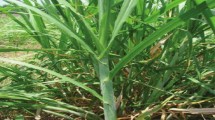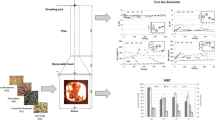Abstract
The thermal conversion of biomass plays an important role in the development of energy reaping technologies and fire engineering. The study investigates the bioenergy potential of Reed Canary (Phalaris arundinacea) through investigating the combustion kinetics and thermal behavior. Reed Canary samples were collected from various rural areas of Ontario, Canada. Four heating rates (10, 20, 30, and 40 °C min−1) were utilized to perform the thermal degradation analysis using a thermogravimetric analyzer. Three different stages were identified ranging from 25 °C to 800 °C in which major degradation stage had two regions from 210 °C to 530 °C where most of the biomass changed into products. Furthermore, iso-conversional models including Kissenger-Akahira-Sunose (KSA), Starink and Flynn–Wall–Ozawa (FWO) were used to evaluate the reaction kinetics such as the activation energy and the pre-exponential factor. The reported kinetics parameters demonstrate the promising potential of Reed Canary for bioenergy production. Moreover, the low cost and the abundance of Reed Canary facilitate the possibility of introducing the biomass as a cost efficient and environmentally friendly natural resource for renewable bioenergy production.






Similar content being viewed by others
Change history
17 August 2021
A Correction to this paper has been published: https://doi.org/10.1007/s13399-021-01861-8
References
Smith DJ, Current D, Schulman C, Easter KW (2018) Willingness to produce perennial bioenergy crops: a contingent supply approach. Biomass Bioenerg 117:161–172
Sparrevik M, Field JL, Martinsen V, et al (2013) Life cycle assessment to evaluate the environmental impact of biochar implementation in conservation agriculture in Zambia. Environ Sci \& Technol 47:1206–1215
Shafiee S, Topal E (2009) When will fossil fuel reserves be diminished? Energy Policy 37:181–189. https://doi.org/10.1016/j.enpol.2008.08.016
Al-Hamamre Z, Saidan M, Hararah M et al (2017) Wastes and biomass materials as sustainable-renewable energy resources for Jordan. Renew Sustain Energy Rev 67:295–314
Uddin MN, Taweekun J, Techato K et al (2019) Sustainable biomass as an alternative energy source: Bangladesh perspective. Energy Procedia 160:648–654
Galanopoulos C, Yan J, Li H, Liu L (2018) Impacts of acidic gas components on combustion of contaminated biomass fuels. Biomass Bioenerg 111:263–277
Gumisiriza R, Hawumba JF, Okure M, Hensel O (2017) Biomass waste-to-energy valorisation technologies: a review case for banana processing in Uganda. Biotechnol Biofuels 10:11. https://doi.org/10.1186/s13068-016-0689-5
Asadi A, Zhang Y, Mohammadi H et al (2019) Combustion and emission characteristics of biomass derived biofuel, premixed in a diesel engine: a CFD study. Renew Energy 138:79–89
White JE, Catallo WJ, Legendre BL (2011) Biomass pyrolysis kinetics: a comparative critical review with relevant agricultural residue case studies. J Anal Appl Pyrolysis 91:1–33. https://doi.org/10.1016/j.jaap.2011.01.004
Liu G, Liao Y, Guo S et al (2016) Thermal behavior and kinetics of municipal solid waste during pyrolysis and combustion process. Appl Therm Eng 98:400–408
Kalogirou SA (2003) Artificial intelligence for the modeling and control of combustion processes: a review. Prog Energy Combust Sci 29:515–566. https://doi.org/10.1016/S0360-1285(03)00058-3
Boubacar Laougé Z, Merdun H (2020) Pyrolysis and combustion kinetics of Sida cordifolia L. using thermogravimetric analysis. Bioresour Technol 299:122602. https://doi.org/10.1016/j.biortech.2019.122602
Boubacar Laougé Z, Merdun H (2020) Kinetic analysis of Pearl Millet (Penissetum glaucum (L.) R. Br.) under pyrolysis and combustion to investigate its bioenergy potential. Fuel 267:117172. https://doi.org/10.1016/j.fuel.2020.117172
Xu X, Pan R, Chen R (2021) Combustion characteristics, kinetics, and thermodynamics of pine wood through thermogravimetric analysis. Appl Biochem Biotechnol 1–20
Gupta S, Gupta GK, Mondal MK (2020) Thermal degradation characteristics, kinetics, thermodynamic, and reaction mechanism analysis of pistachio shell pyrolysis for its bioenergy potential. Biomass Convers Biorefinery 1–15
Akahira T, Sunose T (1969) Transactions of Joint Convention of Four Electrical Institutes. 246
Ozawa T (1965) A new method of analyzing thermogravimetric data. Bull Chem Soc Jpn 38:1881–1886
Flynn JH, Wall LA (1966) A quick, direct method for the determination of activation energy from thermogravimetric data. J Polym Sci Part B Polym Lett 4:323–328
Starink MJ (2003) The determination of activation energy from linear heating rate experiments: a comparison of the accuracy of isoconversion methods. Thermochim Acta 404:163–176
Doyle CD (1961) Kinetic analysis of thermogravimetric data. J Appl Polym Sci 5:285–292
Vyazovkin S, Chrissafis K, Di Lorenzo ML et al (2014) ICTAC Kinetics Committee recommendations for collecting experimental thermal analysis data for kinetic computations. Thermochim Acta 590:1–23. https://doi.org/10.1016/j.tca.2014.05.036
Gotor FJ, Criado JM, Malek J, Koga N (2000) Kinetic analysis of solid-state reactions: the universality of master plots for analyzing isothermal and nonisothermal experiments. J Phys Chem A 104:10777–10782. https://doi.org/10.1021/jp0022205
Machado JC, Carneiro PCS, da Costa CJ et al (2017) Elephant grass ecotypes for bioenergy production via direct combustion of biomass. Ind Crops Prod 95:27–32
Paniagua S, Prado-Guerra A, García AI, Calvo LF (2019) Bioenergy derived from an organically fertilized poplar plot: overall TGA and index estimation study for combustion, gasification, and pyrolysis processes. Biomass Convers Biorefinery 9:749–760. https://doi.org/10.1007/s13399-019-00392-7
Nhuchhen DR, Salam PA (2012) Estimation of higher heating value of biomass from proximate analysis: a new approach. Fuel 99:55–63
Xu Y, Chen B (2013) Investigation of thermodynamic parameters in the pyrolysis conversion of biomass and manure to biochars using thermogravimetric analysis. Bioresour Technol 146:485–493
Braga RM, Melo DMA, Aquino FM et al (2014) Characterization and comparative study of pyrolysis kinetics of the rice husk and the elephant grass. J Therm Anal Calorim 115:1915–1920
Biney PO, Gyamerah M, Shen J, Menezes B (2015) Kinetics of the pyrolysis of arundo, sawdust, corn stover and switch grass biomass by thermogravimetric analysis using a multi-stage model. Bioresour Technol 179:113–122
Maia AAD, de Morais LC (2016) Kinetic parameters of red pepper waste as biomass to solid biofuel. Bioresour Technol 204:157–163
Mehmood MA, Ye G, Luo H et al (2017) Pyrolysis and kinetic analyses of Camel grass (Cymbopogon schoenanthus) for bioenergy. Bioresour Technol 228:18–24
Ahmad MS, Mehmood MA, Al Ayed OS et al (2017) Kinetic analyses and pyrolytic behavior of Para grass (Urochloa mutica) for its bioenergy potential. Bioresour Technol 224:708–713
Huang L, Liu J, He Y et al (2016) Thermodynamics and kinetics parameters of co-combustion between sewage sludge and water hyacinth in CO 2/O 2 atmosphere as biomass to solid biofuel. Bioresour Technol 218:631–642
Niu H, Liu N (2015) Thermal decomposition of pine branch: unified kinetic model on pyrolytic reactions in pyrolysis and combustion. Fuel 160:339–345
Ding Y, Huang B, Wu C et al (2019) Kinetic model and parameters study of lignocellulosic biomass oxidative pyrolysis. Energy 181:11–17
Zou H, Evrendilek F, Liu J, Buyukada M (2019) Combustion behaviors of pileus and stipe parts of Lentinus edodes using thermogravimetric-mass spectrometry and Fourier transform infrared spectroscopy analyses: thermal conversion, kinetic, thermodynamic, gas emission and optimization analyses. Bioresour Technol 288:121481
Turmanova SC, Genieva SD, Dimitrova AS, Vlaev LT (2008) Non-isothermal degradation kinetics of filled with rise husk ash polypropene composites. Express Polym Lett 2:133–146
Ahmad MS, Mehmood MA, Ye G et al (2017) Thermogravimetric analyses revealed the bioenergy potential of Eulaliopsis binata. J Therm Anal Calorim. https://doi.org/10.1007/s10973-017-6398-x
Wu W, Mei Y, Zhang L et al (2015) Kinetics and reaction chemistry of pyrolysis and combustion of tobacco waste. Fuel 156:71–80
Chen R, Li Q, Xu X, et al (2020) Combustion characteristics, kinetics and thermodynamics of Pinus Sylvestris pine needle via non-isothermal thermogravimetry coupled with model-free and model-fitting methods. Case Stud Therm Eng 22:100756
Rathore NS, Pawar A, Panwar NL (2021) Kinetic analysis and thermal degradation study on wheat straw and its biochar from vacuum pyrolysis under non-isothermal condition. Biomass Convers Biorefinery 1–13
Yaras A, Demirel B, Akkurt F, Arslanoglu H (2021) Thermal conversion behavior of paper mill sludge: characterization, kinetic, and thermodynamic analyses. Biomass Convers Biorefinery. https://doi.org/10.1007/s13399-020-01232-9
Acknowledgements
This project was funded by the Deanship of Scientific Research (DSR) at King Abdulaziz University, Jeddah, under grant no. (RG-5-135-41). The authors, therefore, acknowledge with thanks DSR technical and financial support.
Author information
Authors and Affiliations
Corresponding author
Additional information
Publisher’s note
Springer Nature remains neutral with regard to jurisdictional claims in published maps and institutional affiliations.
Rights and permissions
About this article
Cite this article
Alhumade, H., Ahmad, M.S., Mauri, E. et al. Investigating the bioenergy potential of invasive Reed Canary (Phalaris arundinacea) through thermal and kinetic analyses. Biomass Conv. Bioref. 13, 7677–7685 (2023). https://doi.org/10.1007/s13399-021-01664-x
Received:
Revised:
Accepted:
Published:
Issue Date:
DOI: https://doi.org/10.1007/s13399-021-01664-x




